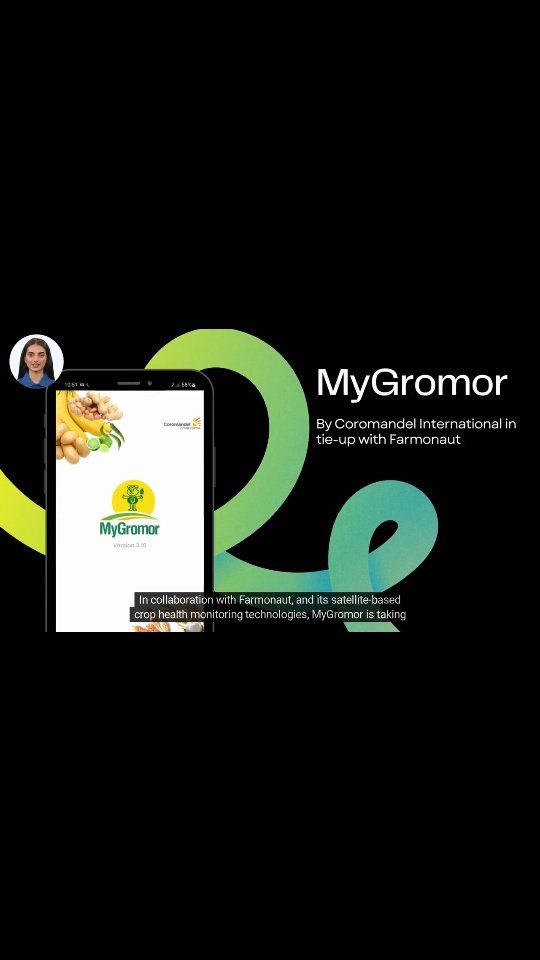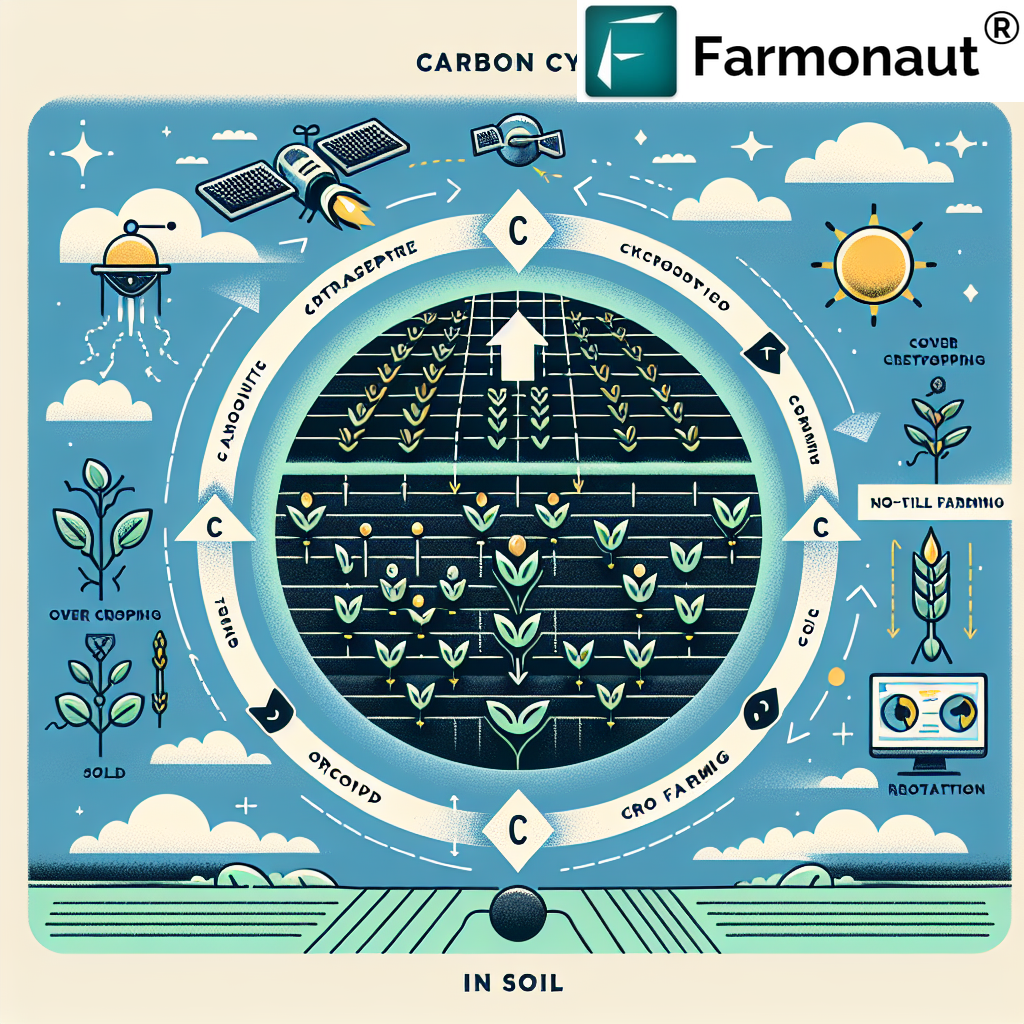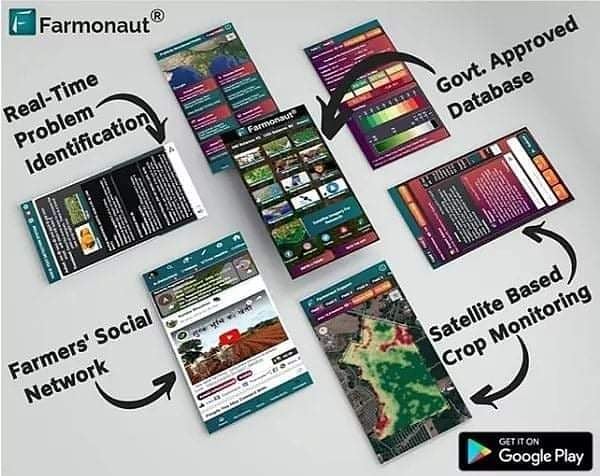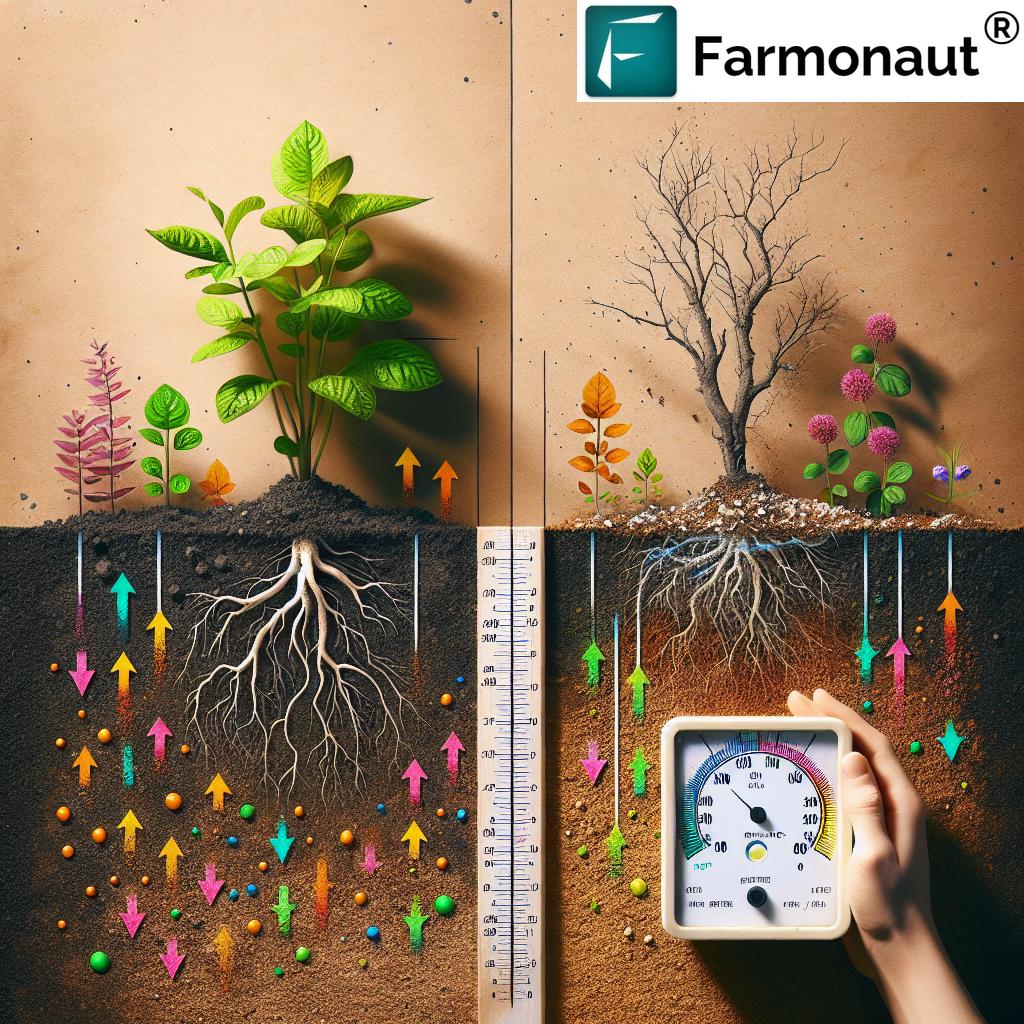Organic vs. Chemical: Effective Treatment for Rice Leaf Spot Disease Caused by Bipolaris Fungi
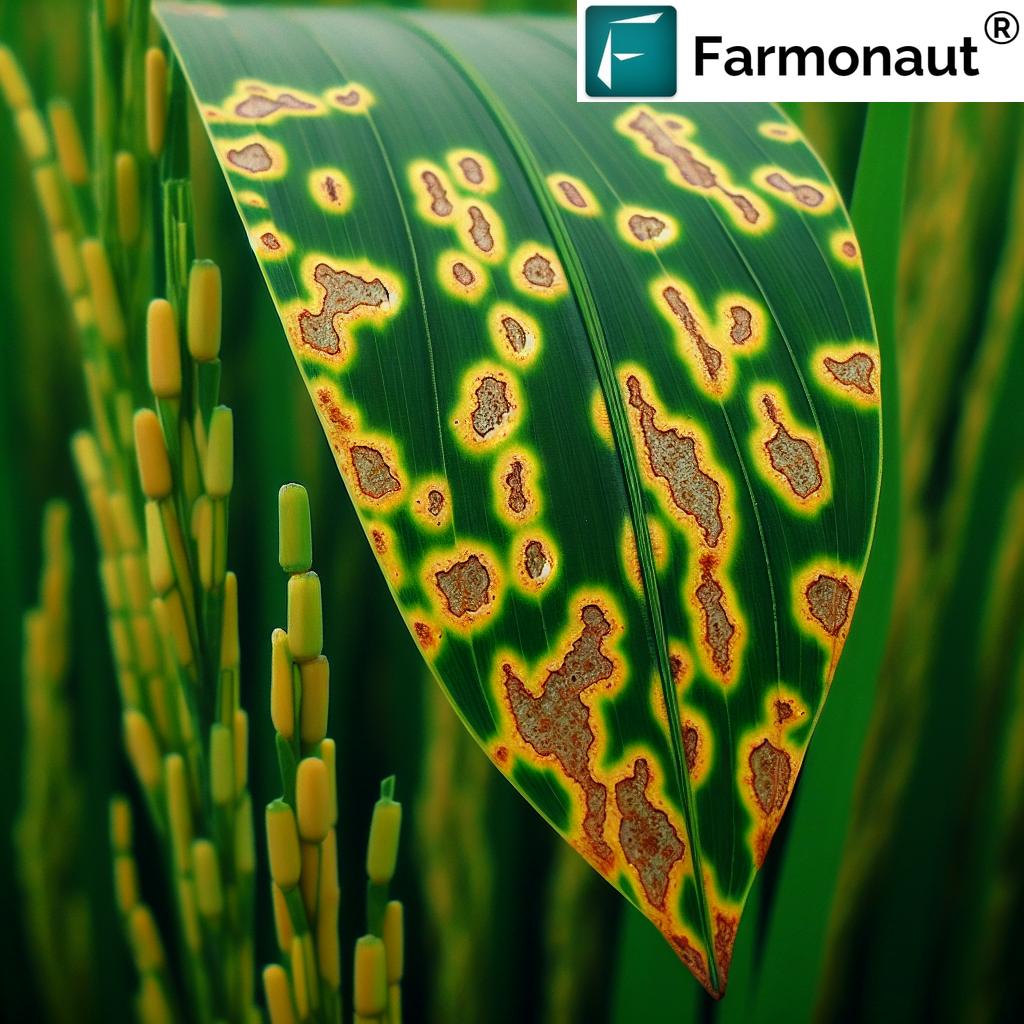
At Farmonaut, we understand the challenges faced by rice farmers in combating leaf spot disease, a significant threat to rice production worldwide. In this comprehensive guide, we’ll explore the causes, symptoms, and most importantly, the effective treatments for this devastating fungal disease. We’ll compare organic and chemical approaches, providing you with the knowledge to make informed decisions for your rice fields.
Understanding Rice Leaf Spot Disease
Rice leaf spot disease, also known as brown spot, is primarily caused by the fungal pathogen Bipolaris oryzae (formerly known as Cochliobolus miyabeanus or Helminthosporium oryzae). This disease can significantly impact rice production, leading to substantial economic losses for farmers.
The Causative Agent: Bipolaris Fungi
The genus Bipolaris includes several species that can affect rice plants. The most common species causing leaf spot in rice are:
- Bipolaris oryzae (syn. Cochliobolus miyabeanus)
- Bipolaris sorokiniana
- Bipolaris australiensis
These fungi are capable of infecting various parts of the rice plant, including leaves, seeds, and glumes.
Symptoms of Rice Leaf Spot Disease
Recognizing the symptoms of rice leaf spot disease is crucial for early detection and effective management. The primary symptoms include:
- Leaf lesions: Small, circular to oval spots appear on the leaves. These spots are typically brown with a grey or whitish center, often surrounded by a yellow halo.
- Enlarging spots: As the disease progresses, the spots may enlarge and coalesce, forming larger necrotic areas on the leaf.
- Seed discoloration: Infected seeds may show brown to black discoloration.
- Glume spotting: Dark spots may appear on the glumes, affecting grain quality.
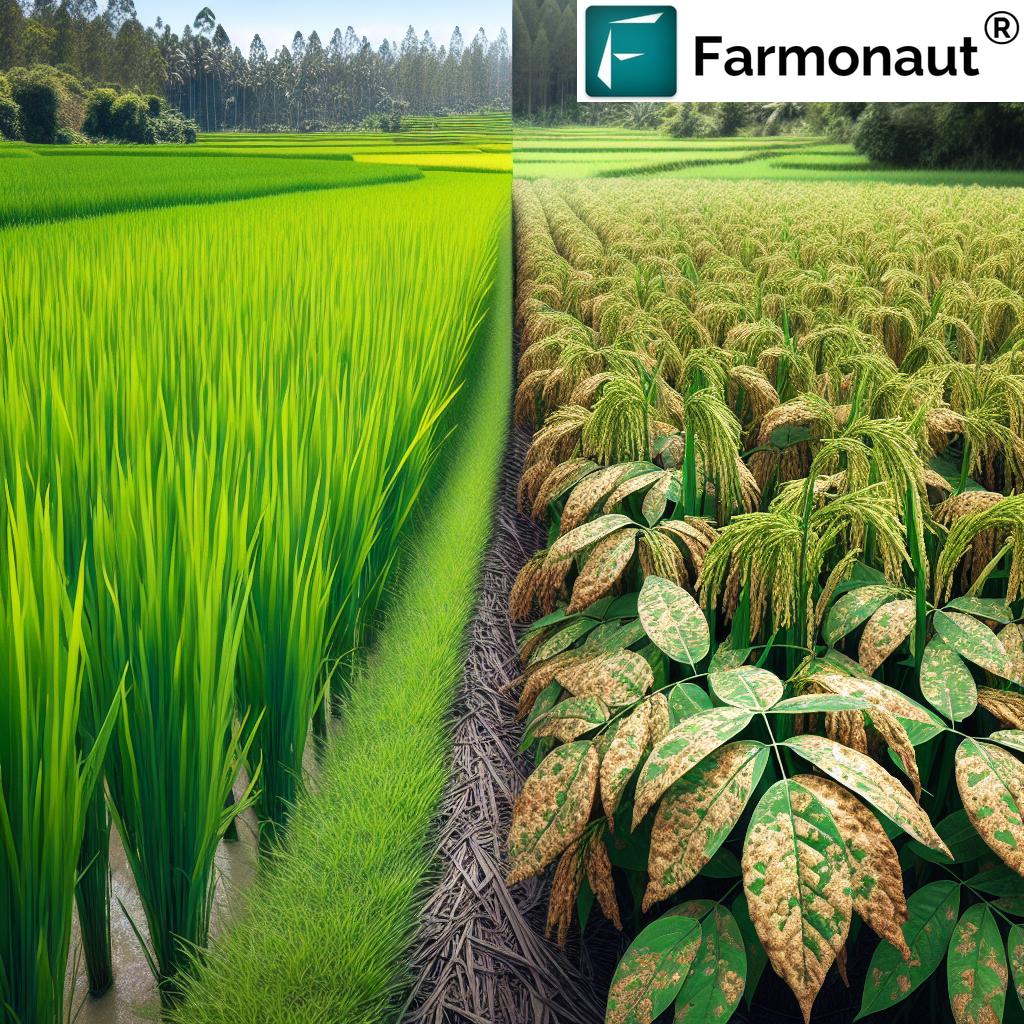
Economic Impact of Rice Leaf Spot Disease
The impact of rice leaf spot disease on crop productivity and farmer livelihoods cannot be overstated. Some key points to consider:
- Yield reduction: Severe infections can lead to significant yield reductions, sometimes up to 50% in highly susceptible varieties.
- Quality degradation: Infected grains often have reduced quality, affecting market value.
- Increased production costs: Managing the disease often requires additional inputs, increasing overall production costs.
Farmonaut’s Role in Early Detection and Management
At Farmonaut, we leverage cutting-edge satellite technology to assist farmers in early detection and management of rice leaf spot disease. Our advanced system offers several advantages over traditional methods:
| Detection Method | Early Symptom Identification | Field Coverage | Cost-Effectiveness | Data Accuracy |
|---|---|---|---|---|
| Farmonaut Satellite System | High – Can detect subtle changes in plant health before visible symptoms appear | Extensive – Covers large areas quickly and efficiently | High – No need for on-site visits for routine monitoring | Very High – Uses advanced algorithms and multispectral imagery |
| Visual Inspection | Moderate – Relies on visible symptoms | Limited – Time-consuming for large fields | Low – Requires frequent field visits | Moderate – Subject to human error |
| Drone Surveys | High – Can detect early symptoms | Good – Covers medium to large areas | Moderate – Initial investment in equipment required | High – Provides detailed imagery |
By utilizing our satellite-based monitoring system, farmers can identify potential disease outbreaks early, allowing for timely intervention and more effective management strategies. To learn more about our services, visit Farmonaut’s application.
Treatment Approaches: Organic vs. Chemical
When it comes to treating rice leaf spot disease, farmers have two primary approaches: organic and chemical. Each method has its advantages and considerations, and the choice often depends on various factors including farm size, severity of infection, and environmental concerns.
Organic Treatment Methods
Organic approaches focus on natural and sustainable methods to control the disease. These methods are particularly popular among farmers looking to reduce chemical inputs and maintain ecological balance in their fields.
1. Crop Rotation
Implementing a proper crop rotation system can help break the disease cycle. By alternating rice with non-host crops, we can reduce the buildup of fungal inoculum in the soil.
2. Resistant Varieties
Planting rice varieties that are resistant or tolerant to leaf spot disease is an effective long-term strategy. We recommend consulting with local agricultural extension services to identify suitable resistant varieties for your region.
3. Biological Control Agents
Several beneficial microorganisms can be used to suppress the growth of Bipolaris fungi. Some effective biocontrol agents include:
- Trichoderma species
- Bacillus subtilis
- Pseudomonas fluorescens
4. Organic Fungicides
Certain plant-based and microbial products can act as effective organic fungicides. Examples include:
- Neem oil
- Garlic extract
- Compost tea
5. Cultural Practices
Implementing good cultural practices can significantly reduce disease pressure:
- Proper spacing between plants to improve air circulation
- Removal and destruction of infected plant debris
- Maintaining optimal soil fertility to promote plant health
Chemical Treatment Methods
Chemical treatments often provide rapid and effective control of rice leaf spot disease, especially in severe outbreaks. However, it’s crucial to use these products judiciously to prevent the development of fungicide resistance and minimize environmental impact.
1. Systemic Fungicides
Systemic fungicides are absorbed by the plant and distributed throughout its tissues. Some effective systemic fungicides for rice leaf spot include:
- Propiconazole
- Azoxystrobin
- Difenoconazole
2. Contact Fungicides
Contact fungicides remain on the plant surface and provide a protective barrier. Examples include:
- Mancozeb
- Chlorothalonil
- Copper-based fungicides
3. Seed Treatments
Treating seeds with fungicides before planting can provide early protection against seed-borne infections. Common seed treatments include:
- Thiram
- Carboxin
- Fludioxonil
4. Foliar Sprays
Applying fungicides as foliar sprays can be effective in controlling active infections. The timing of application is crucial for maximum efficacy.
Integrated Pest Management (IPM) Approach
At Farmonaut, we advocate for an Integrated Pest Management (IPM) approach, which combines various control methods to achieve effective and sustainable disease management. This approach integrates both organic and chemical methods, along with cultural practices and advanced monitoring techniques.
Key Components of IPM for Rice Leaf Spot Disease
- Monitoring and Early Detection: Utilize Farmonaut’s satellite-based monitoring system for early detection of disease symptoms. Regular field scouting complements this technology.
- Cultural Practices: Implement good agricultural practices such as proper plant spacing, balanced fertilization, and field sanitation.
- Biological Control: Incorporate beneficial microorganisms to suppress pathogen growth.
- Host Plant Resistance: Choose rice varieties with genetic resistance to leaf spot disease.
- Chemical Control: Use fungicides judiciously, only when necessary and as part of a broader management strategy.
- Data-Driven Decision Making: Leverage Farmonaut’s AI-powered advisory system to make informed decisions about disease management strategies.
To access our advanced monitoring and advisory services, visit our Farmonaut Satellite API page.
Environmental Considerations and Sustainable Practices
As stewards of the land, it’s our responsibility to consider the environmental impact of our disease management practices. Here are some key considerations:
1. Soil Health
Maintaining healthy soil is crucial for plant resilience against diseases. Practices that promote soil health include:
- Crop rotation
- Cover cropping
- Minimal tillage
- Organic matter incorporation
2. Water Management
Proper water management can help reduce disease pressure. Consider:
- Avoiding over-irrigation
- Implementing alternate wetting and drying techniques
- Improving field drainage
3. Biodiversity
Enhancing biodiversity in and around rice fields can promote natural pest control and reduce disease incidence:
- Maintain field margins with diverse plant species
- Incorporate beneficial insects habitats
- Practice intercropping where feasible
4. Responsible Chemical Use
When using chemical fungicides, follow these guidelines:
- Use only approved products at recommended rates
- Rotate fungicides with different modes of action to prevent resistance
- Observe pre-harvest intervals and safety precautions
- Dispose of chemical containers properly
Future Trends in Rice Leaf Spot Disease Management
As technology and research advance, new opportunities for managing rice leaf spot disease are emerging. At Farmonaut, we’re at the forefront of these developments:
1. Precision Agriculture
Our satellite-based monitoring system is part of the precision agriculture revolution. This technology allows for targeted interventions, reducing overall pesticide use and improving efficiency.
2. Genetic Engineering
Research into genetically engineered rice varieties with enhanced resistance to leaf spot disease is ongoing. While controversial, this approach could provide new tools for disease management.
3. Nanotechnology
Nanoparticle-based fungicides and delivery systems are being developed, potentially offering more effective and environmentally friendly disease control options.
4. Artificial Intelligence and Machine Learning
Our AI-powered advisory system, continually refined with machine learning algorithms, provides increasingly accurate disease predictions and management recommendations.
5. Climate-Smart Agriculture
As climate change impacts disease patterns, adaptive strategies incorporating climate data will become crucial. Farmonaut’s integration of weather data into our monitoring system is a step in this direction.
To stay updated on these advancements and how they can benefit your farm, download our mobile app:
Case Studies: Successful Management of Rice Leaf Spot Disease
While we don’t include specific case studies or success stories, we can share general observations from our extensive work with rice farmers:
- Farmers using integrated pest management approaches consistently report lower disease incidence and higher yields.
- Early detection through satellite monitoring has allowed for timely interventions, significantly reducing crop losses.
- Combining resistant varieties with judicious use of organic and chemical controls has proven effective in managing severe outbreaks.
- Farmers implementing soil health improvement practices report increased plant resilience to leaf spot disease over time.
FAQs about Rice Leaf Spot Disease
Q1: How does rice leaf spot disease spread?
A1: The disease primarily spreads through infected seeds, crop residues, and airborne spores. Warm, humid conditions favor its spread.
Q2: Can rice leaf spot disease be completely eradicated?
A2: Complete eradication is challenging. The focus should be on effective management to minimize its impact on yield and quality.
Q3: Are organic treatments as effective as chemical treatments?
A3: Organic treatments can be very effective, especially as part of an integrated management approach. Their efficacy often builds over time as soil health improves.
Q4: How often should I monitor my rice fields for leaf spot disease?
A4: Regular monitoring is crucial. With Farmonaut’s satellite monitoring, you can receive updates every 3-5 days, complemented by weekly in-field scouting.
Q5: Can crop rotation help in managing rice leaf spot disease?
A5: Yes, crop rotation can be very effective. It helps break the disease cycle by reducing the buildup of fungal inoculum in the soil.
Conclusion
Managing rice leaf spot disease requires a comprehensive, integrated approach combining the best of organic and chemical methods. At Farmonaut, we’re committed to providing farmers with the tools and knowledge needed to effectively combat this challenging disease.
By leveraging our advanced satellite monitoring technology, AI-powered advisory system, and commitment to sustainable agriculture, we can work together to minimize the impact of leaf spot disease and ensure healthy, productive rice crops.
For more information on how Farmonaut can help you manage rice leaf spot disease and other agricultural challenges, visit our API documentation or subscribe to our services below:
Together, we can cultivate a future of resilient, sustainable rice production.





